Spatiotemporal Analysis of Human Mobility in Manila Metropolitan Area with Person-Trip Data
Abstract
:1. Introduction
2. Data and Methodology
2.1. Technical Difficulty on Geo-Tagged Big Data and the Application of Person-Trip Data Survey
2.2. Study Framework
2.3. Study Area and Description of the Sample
3. Results and Discussion
3.1. Identification and Classification of Urban Nucleuses
3.2. Pattern of Connection and Influence among Urban Nucleuses
3.3. Spatiotemporal Structures and Characteristics of Human Mobility in the Whole Manila Metropolitan Area
3.4. Spatiotemporal Patterns of Human Mobility in Urban Nucleuses
3.4.1. Urban Nucleuses with Central City Type
3.4.2. Urban Nucleuses with Business City Type
3.4.3. Urban Nucleuses with Commuter Town Type
3.4.4. Urban Nucleuses with South and North Suburb Type
3.4.5. Urban Nucleuses with Subcenter City Type
3.5. Limitations and Suggested Improvement
4. Conclusions
Acknowledgments
Conflicts of Interest
Appendix A
| ID | Province | Place Name | ID | Province | Place Name |
|---|---|---|---|---|---|
| 1 | Metropolitan Manila | Manila | 34 | Bulacan | Plaridel |
| 2 | Mandaluyong | 35 | Pulilan | ||
| 3 | Marikina | 36 | San Jose del Monte | ||
| 4 | Pasig | 37 | Santa Maria | ||
| 5 | Quezon | 38 | Pampanga | Apalit | |
| 6 | San Juan | 39 | Macabebe | ||
| 7 | Caloocan | 40 | Masantol | ||
| 8 | Malabon | 41 | Cavite | Bacoor | |
| 9 | Navotas | 42 | Carmona | ||
| 10 | Valenzuela | 43 | Cavite City | ||
| 11 | Las Piñas | 44 | Dasmariñas | ||
| 12 | Makati City | 45 | General Trias | ||
| 13 | Muntinlupa | 46 | Imus | ||
| 14 | Parañque | 47 | Kawit | ||
| 15 | Pasay | 48 | Naic | ||
| 16 | Pateros | 49 | Noveleta | ||
| 17 | Taguig | 50 | Rosario | ||
| 18 | Bulacan | Angat | 51 | Silang | |
| 19 | Balagtas | 52 | Tanza | ||
| 20 | Baliuag | 53 | Trece Martires | ||
| 21 | Bocaue | 54 | General Mariano Alvarez | ||
| 22 | Bulacan | 55 | Laguna | Biñan | |
| 23 | Bustos | 56 | Cabuyao | ||
| 24 | Calumpit | 57 | Calamba | ||
| 25 | Guiguinto | 58 | Los Baños | ||
| 26 | Hagonoy | 59 | San Pedro | ||
| 27 | Malolos | 60 | Santa Rosa | ||
| 28 | Marilao | 61 | Rizal | Angono | |
| 29 | Meycauayan | 62 | Antipolo | ||
| 30 | Norzagaray | 63 | Cainta | ||
| 31 | Obando | 64 | Rodriguez | ||
| 32 | Pandi | 65 | San Mateo | ||
| 33 | Paombong | 66 | Taytay |
References
- Burgess, E.W. The Growth of the City: An Introduction to a Research Project. In Urban Ecology; Marzluff, J.M., Shulenberger, E., Endlicher, W., Alberti, M., Bradley, G., Ryan, C., Simon, U., ZumBrunnen, C., Eds.; Springer: Boston, MA, USA, 2008; pp. 71–78. Available online: https://link.springer.com/content/pdf/10.1007%2F978-0-387-73412-5.pdf (accessed on 4 January 2018).
- Hoyt, H. The Structure and Growth of Residential Neighborhoods in American Cities; Federal Housing Administration: Washington, DC, USA, 1939. Available online: https://ia800503.us.archive.org/30/items/structuregrowtho00unitrich/structuregrowtho00unitrich.pdf (accessed on 4 January 2018).
- Harris, C.D.; Ullman, E.L. The nature of cities. Ann. Am. Acad. Political Soc. Sci. 1945, 242, 7–17. [Google Scholar] [CrossRef]
- Rodwin, L. The Theory of Residential Growth and Structure. Apprais. J. 1950, 18, 295–317. [Google Scholar]
- Boarnet, M.G.; Hong, A.; Santiago-Bartolomei, R. Urban spatial structure, employment subcenters, and freight travel. J. Transp. Geogr. 2017, 60, 267–276. [Google Scholar] [CrossRef]
- McDonald, J.F.; McMillen, D.P. Employment subcenters and land values in a polycentric urban area: The case of Chicago. Environ. Plan. A 1990, 22, 1561–1574. [Google Scholar] [CrossRef]
- Richardson, H.W. Urban Economics; Dryden Press: Hinsdale, IL, USA, 1978. [Google Scholar]
- Ishikawa, Y. The Trend of Multinucleation and the Characteristics of Suburban Nucleations in the Keihanshin Metropolitan Area. Geogr. Rev. Jpn. 1996, 69, 387–414. (In Japanese) [Google Scholar] [CrossRef]
- Komaki, N. Functional structure of the Tokyo metropolitan area based on the analysis of commuting and consuming activities. New Geogr. 2004, 52, 1–15. (In Japanese) [Google Scholar] [CrossRef]
- Hartshorn, T.A.; Muller, O.P. Suburban downtowns and the transformation of metropolitan Atlanta’s business landscape. Urban Geogr. 1989, 10, 375–395. [Google Scholar] [CrossRef]
- Fujii, T.; Hartshorni, T.A. The changing metropolitan structure of Atlanta, Georigia: Locations of fuctions and regional structure in a multinucleated urban area. Urban Geogr. 1995, 16, 680–707. [Google Scholar] [CrossRef]
- Novák, J.; Sýkora, L. A city in motion: Time-space activity and mobility patterns of suburban inhabitants and the structuration of the spatial organization of the Prague metropolitan area. Geogr. Ann. Ser. B Hum. Geogr. 2007, 89, 147–168. [Google Scholar] [CrossRef]
- Liu, Y.; Kang, C.; Gao, S.; Xiao, Y.; Tian, Y. Understanding intra-urban patterns from taxi trajectory data. J. Transp. Geogr. 2012, 14, 463–483. [Google Scholar] [CrossRef]
- Liu, X.; Gong, L.; Gong, Y.; Liu, Y. Revealing travel patterns and city structure with taxi trip data. J. Transp. Geogr. 2015, 43, 78–90. [Google Scholar] [CrossRef]
- Hawelka, B.; Sitko, I.; Beinat, E.; Sobolevsky, S.; Kazakopoulos, P.; Ratti, C. Geo-located Twitter as proxy for global mobility patterns. Cartogr. Geogr. Inf. Sci. 2014, 41, 260–271. [Google Scholar] [CrossRef] [PubMed]
- Li, R.; Tong, D. Constructing human activity spaces: A new approach incorporating complex urban activity-travel. J. Transp. Geogr. 2017, 56, 23–35. [Google Scholar] [CrossRef]
- Roux, L.G.; Vallée, J.; Commenges, H. Social segregation around the clock in the Paris region (France). J. Transp. Geogr. 2017, 59, 134–145. [Google Scholar] [CrossRef]
- Liu, Y.; Wang, F.; Xiao, Y.; Gao, S. Urban land uses and traffic ‘source-sink areas’: Evidence from GPS-enabled taxi data in Shanghai. Landsc. Urban Plan. 2012, 106, 73–87. [Google Scholar] [CrossRef]
- Kong, X.; Liu, Y.; Wang, Y.; Tong, D.; Zhang, J. Investigating Public Facility Characteristics from a Spatial Interaction Perspective: A Case Study of Beijing Hospitals Using Taxi Data. ISPRS Int. J. Geo-Inf. 2017, 6, 38. [Google Scholar] [CrossRef]
- Yang, X.; Fang, Z.; Xu, Y.; Shaw, S.L.; Zhao, Z.; Yin, L.; Zhang, T.; Lin, Y. Understanding spatiotemporal patterns of human convergence and divergence using mobile phone location data. ISPRS Int. J. Geo-Inf. 2016, 5, 177. [Google Scholar] [CrossRef]
- Li, Y.; Li, Q.; Shan, J. Discover patterns and mobility of Twitter users—A study of four US college cities. ISPRS Int. J. Geo-Inf. 2017, 6, 42. [Google Scholar] [CrossRef]
- Center for Spatial Information Science (CSIS), University of Tokyo. Specification Document of Web API, Ver. 2.72. 2016. Available online: http://pflow.csis.u-tokyo.ac.jp/wp-content/uploads/webapi.pdf (accessed on 13 December 2017).
- National Economic and Development Authority. Building Globally Competitive Metro Areas in the Philippines. 2007. Available online: http://www.neda.gov.ph/devpulse/pdf_files/Devpulse%20factsheet%20-%20Aug%2030%20issue.pdf (accessed on 27 December 2017).
- Estoque, R.C. Manila Metropolitan Area. In Urban Development in Asia and Africa; Murayama, Y., Kamusoko, C., Yamashita, A., Estoque, R., Eds.; The Urban Book Series; Springer: Singapore, 2017; pp. 85–110. [Google Scholar]
- Philippines Statistics Authority. Summary of Projected Population by Region, by Single-Year Interval, Philippines: 1995–2005. Available online: https://psa.gov.ph/sites/default/files/attachments/hsd/article/PDPOPPROJdt9.pdf (accessed on 13 December 2017).
- Liu, X.; Wang, M. How polycentric is urban China and why? A case study of 318 cities. Landsc. Urban Plan. 2016, 151, 10–20. [Google Scholar] [CrossRef]
- Veneri, P. The identification of sub-centres in two Italian metropolitan areas: A functional approach. Cities 2013, 31, 177–185. [Google Scholar] [CrossRef]
- Japan International Cooperation Agency (JICA). Metro Manila Urban Transportation Integration Study; Technical Report; No. 4. Transportation Demand Characteristics Based on Person Trip Survey; Japan International Cooperation Agency: Tokyo, Japan, 1999. Available online: http://open_jicareport.jica.go.jp/pdf/11580503_01.pdf (accessed on 13 December 2017).

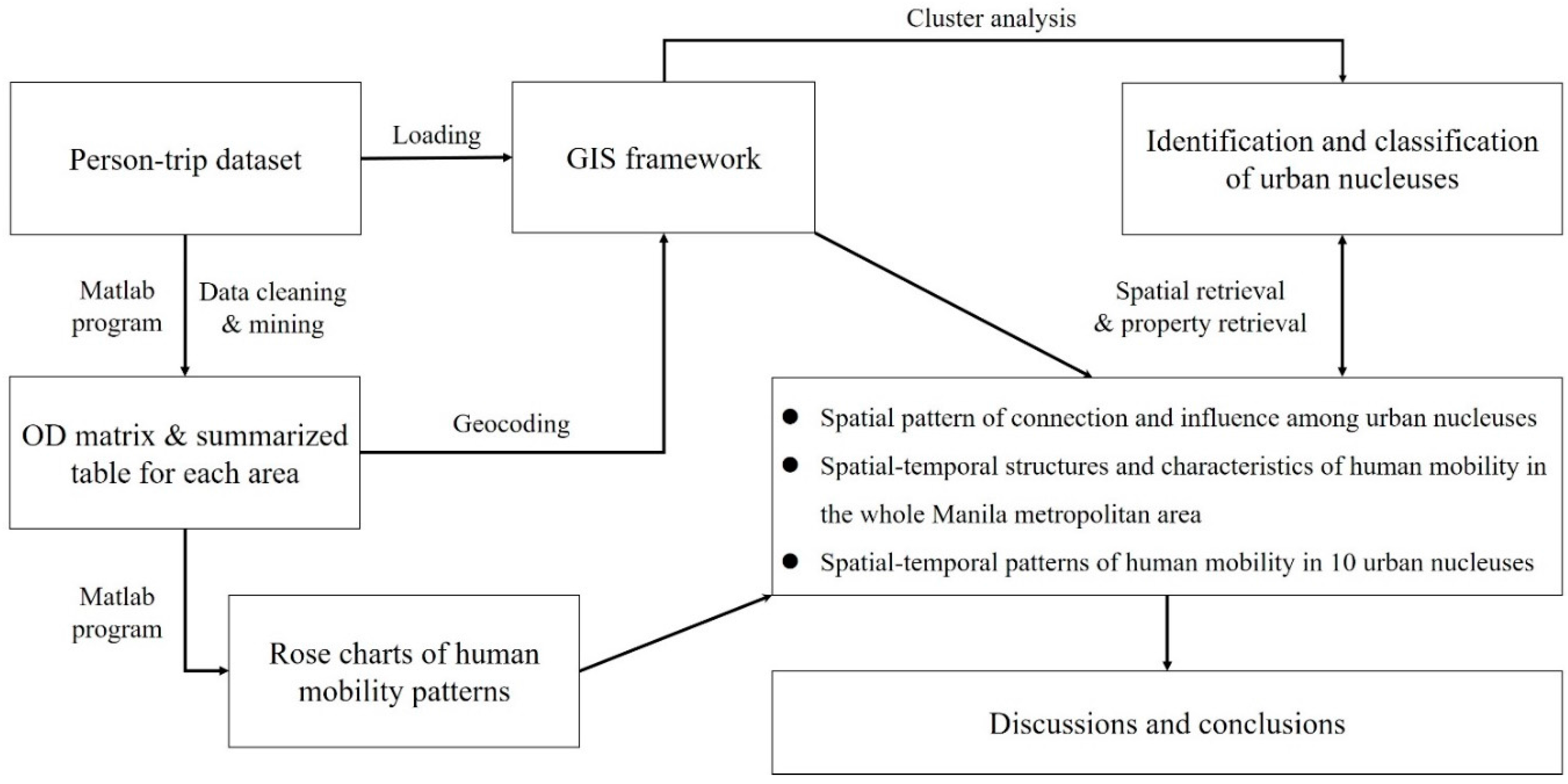
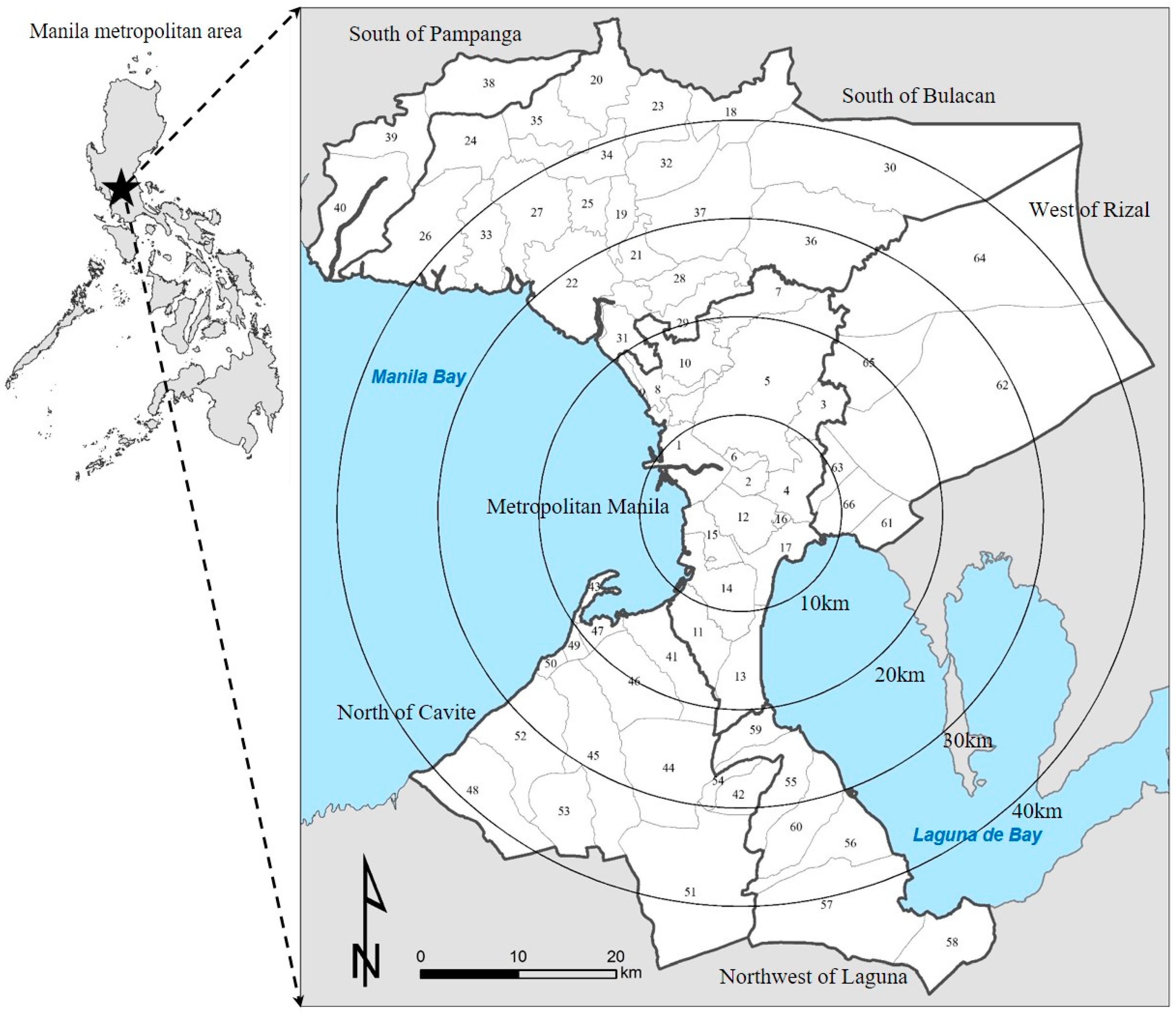



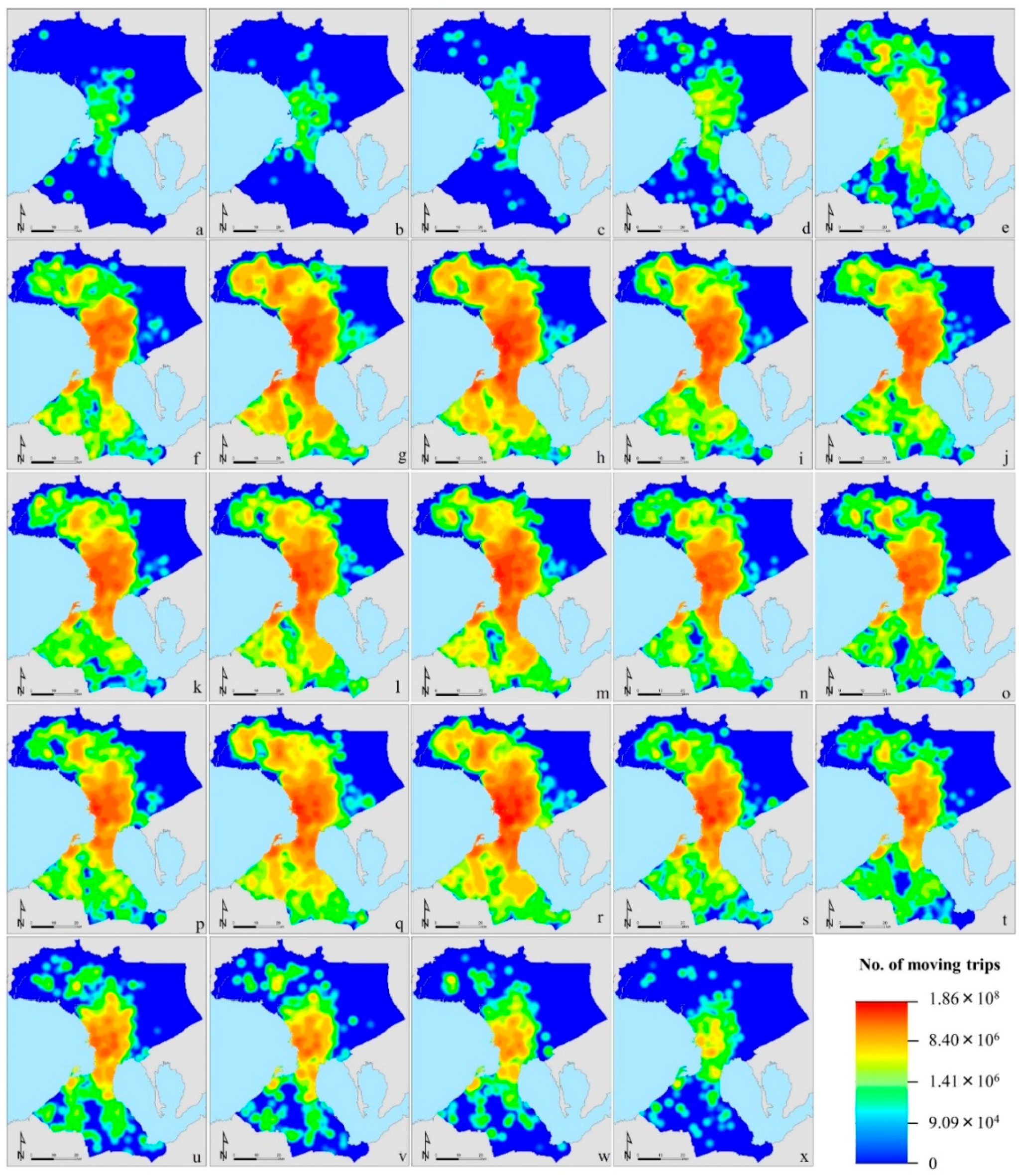
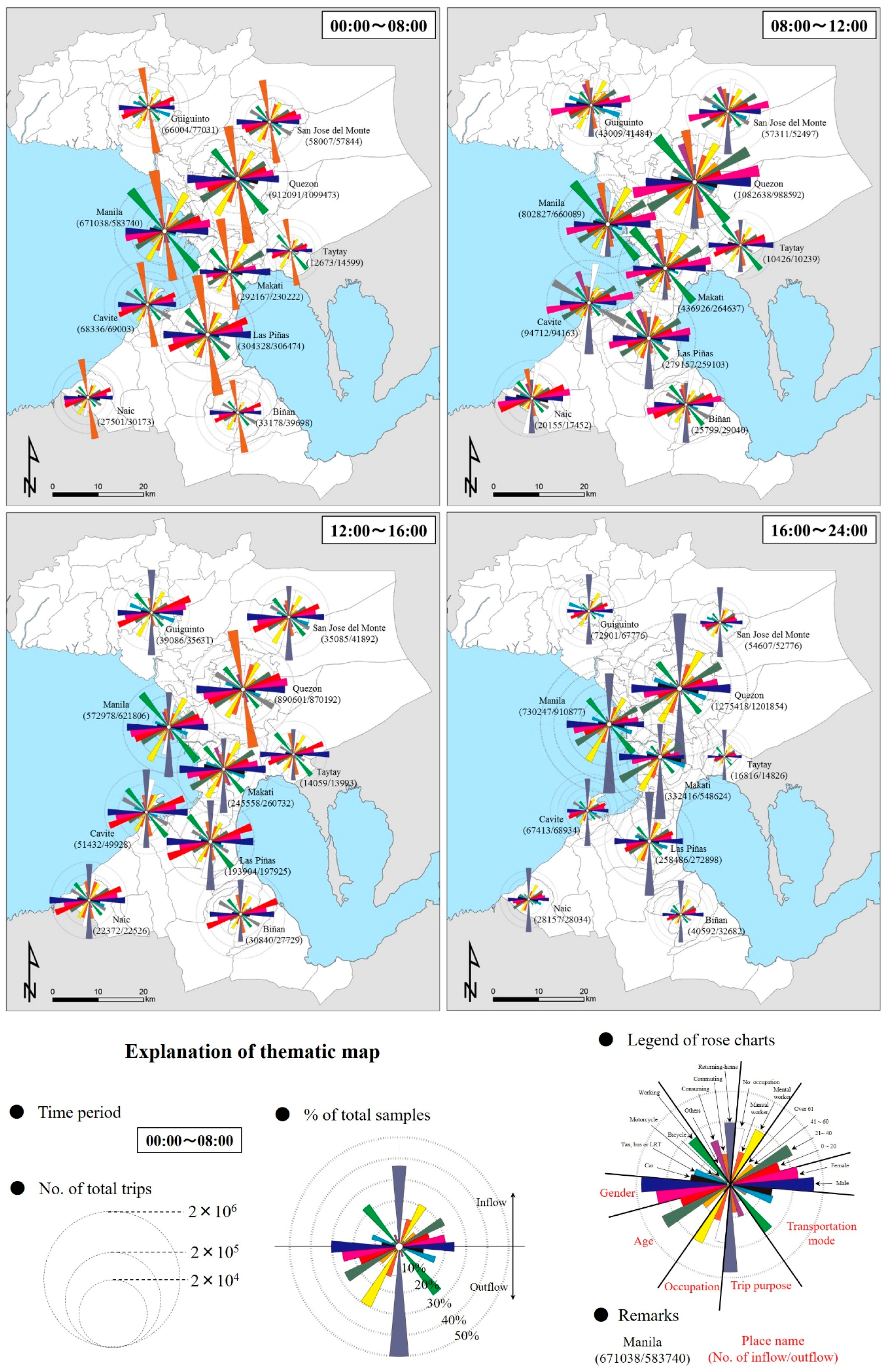
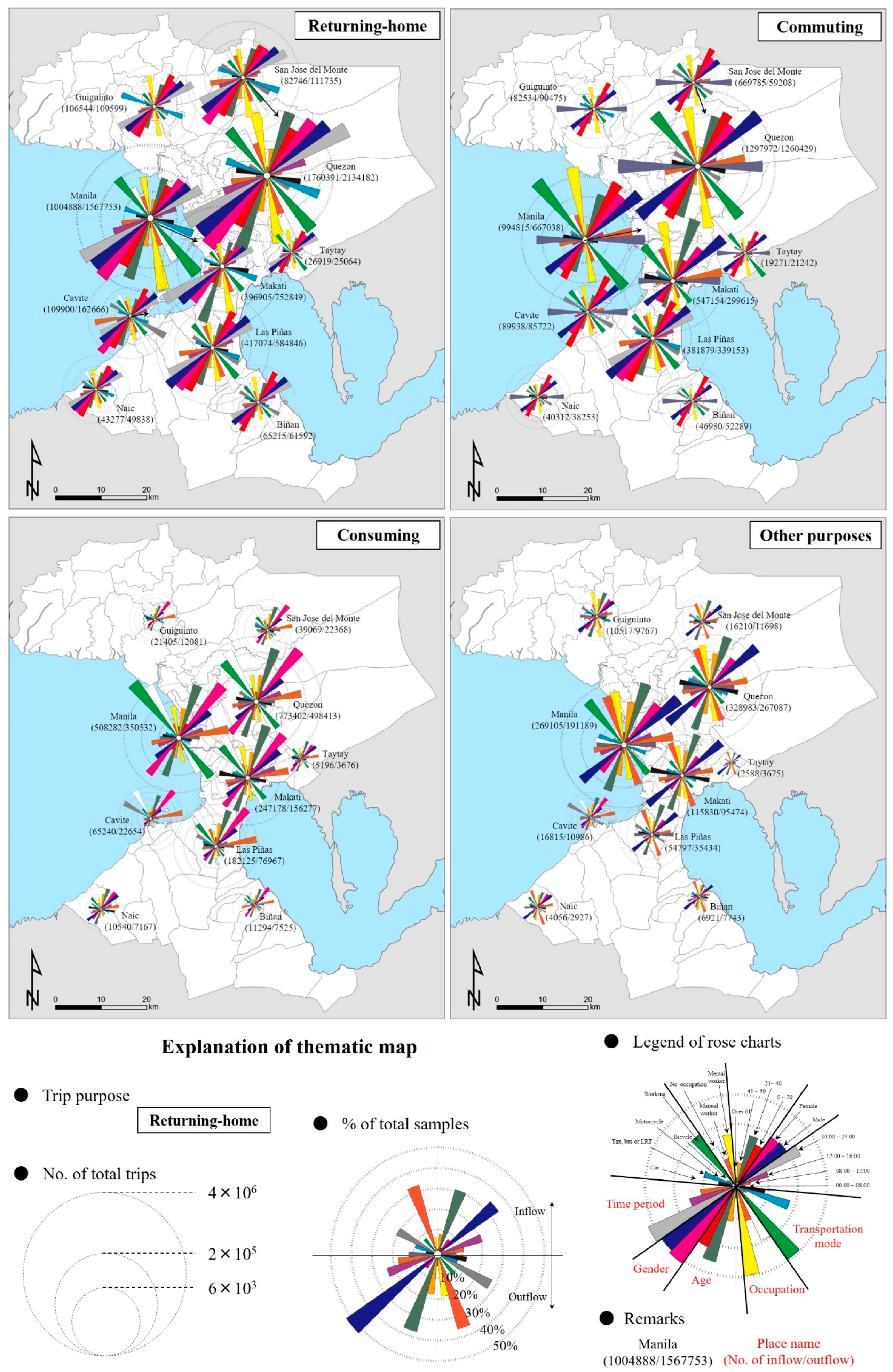
| Item | Number of Sub Trips | ≤3 | 4–6 | 7–9 | 10–13 | ≥14 | Estimated Population | Number of Samples |
|---|---|---|---|---|---|---|---|---|
| Gender | Male | 1420 | 4339 | 586 | 102 | 22 | 6468 | 88 |
| Female | 2133 | 4332 | 441 | 34 | 2 | 6942 | 102 | |
| Age | ≤20 | 810 | 3470 | 299 | 8 | 0.5 | 4587 | 69 |
| 21–30 | 820 | 2003 | 243 | 36 | 6 | 3108 | 39 | |
| 31–40 | 653 | 1504 | 225 | 48 | 8 | 2439 | 33 | |
| 41–50 | 528 | 919 | 148 | 28 | 6 | 1629 | 25 | |
| 51–60 | 356 | 468 | 68 | 11 | 3 | 905 | 14 | |
| ≥61 | 387 | 306 | 43 | 5 | 0.4 | 742 | 10 | |
| Occupation | Mental worker | 633 | 3334 | 420 | 47 | 6 | 4440 | 61 |
| Manual worker | 487 | 1798 | 279 | 67 | 17 | 2647 | 37 | |
| No occupation | 2119 | 3372 | 307 | 19 | 0.8 | 5817 | 85 | |
| Others or unknown | 313 | 167 | 21 | 3 | 0.4 | 506 | 7 | |
| Total | 3552 | 8671 | 1027 | 136 | 24 | 13,410 | 189 | |
| Original Code | Categories of Trip Purpose (Before) | Description in this Case (After) |
|---|---|---|
| 1 | To Home | Home-returning activities |
| 2 | To Work | Commuting activities |
| 3 | To School | |
| 4 | Private affairs | Consuming activities |
| 5 | Employer’s business | Others or unknown |
| 6 | Medical | Consuming activities |
| 7 | Social | |
| 8 | Eating | |
| 9 | Shopping | |
| 10 | Church | Others or unknown |
| 11 | Accompany other household members | Consuming activities |
| 12 | Others | Others or unknown |
| 97 | No-moving | Unexplored |
| 99 | Unknown | Others or unknown |
| Group (No. of Areas) | A (10) | B (2) | C (2) | D (4) | E (4) | F (2) |
|---|---|---|---|---|---|---|
| To Home | 41.52% | 30.72% | 47.49% | 44.99% | 48.59% | 46.06% |
| To Work | 17.10% | 17.74% | 10.43% | 20.87% | 18.39% | 12.13% |
| To School | 15.46% | 28.92% | 31.29% | 22.84% | 21.42% | 20.62% |
| Private affairs | 2.39% | 4.33% | 1.57% | 1.62% | 1.60% | 1.58% |
| Employer’s business | 6.66% | 7.53% | 3.54% | 3.80% | 3.19% | 5.03% |
| Medical | 0.46% | 0.35% | 0.56% | 0.12% | 0.35% | 0.29% |
| Social | 2.18% | 3.44% | 1.31% | 1.84% | 1.41% | 2.56% |
| Eating | 1.26% | 2.28% | 0.03% | 0.44% | 0.45% | 1.17% |
| Shopping | 7.01% | 2.73% | 2.50% | 1.96% | 3.36% | 8.23% |
| Church | 2.70% | 0.11% | 0.30% | 0.21% | 0.22% | 0.31% |
| Accompany other household members | 2.27% | 1.48% | 0.66% | 0.76% | 0.70% | 1.52% |
| Others | 1.00% | 0.38% | 0.31% | 0.53% | 0.32% | 0.50% |
© 2018 by the author. Licensee MDPI, Basel, Switzerland. This article is an open access article distributed under the terms and conditions of the Creative Commons Attribution (CC BY) license (http://creativecommons.org/licenses/by/4.0/).
Share and Cite
Liu, K. Spatiotemporal Analysis of Human Mobility in Manila Metropolitan Area with Person-Trip Data. Urban Sci. 2018, 2, 3. https://doi.org/10.3390/urbansci2010003
Liu K. Spatiotemporal Analysis of Human Mobility in Manila Metropolitan Area with Person-Trip Data. Urban Science. 2018; 2(1):3. https://doi.org/10.3390/urbansci2010003
Chicago/Turabian StyleLiu, Kai. 2018. "Spatiotemporal Analysis of Human Mobility in Manila Metropolitan Area with Person-Trip Data" Urban Science 2, no. 1: 3. https://doi.org/10.3390/urbansci2010003





